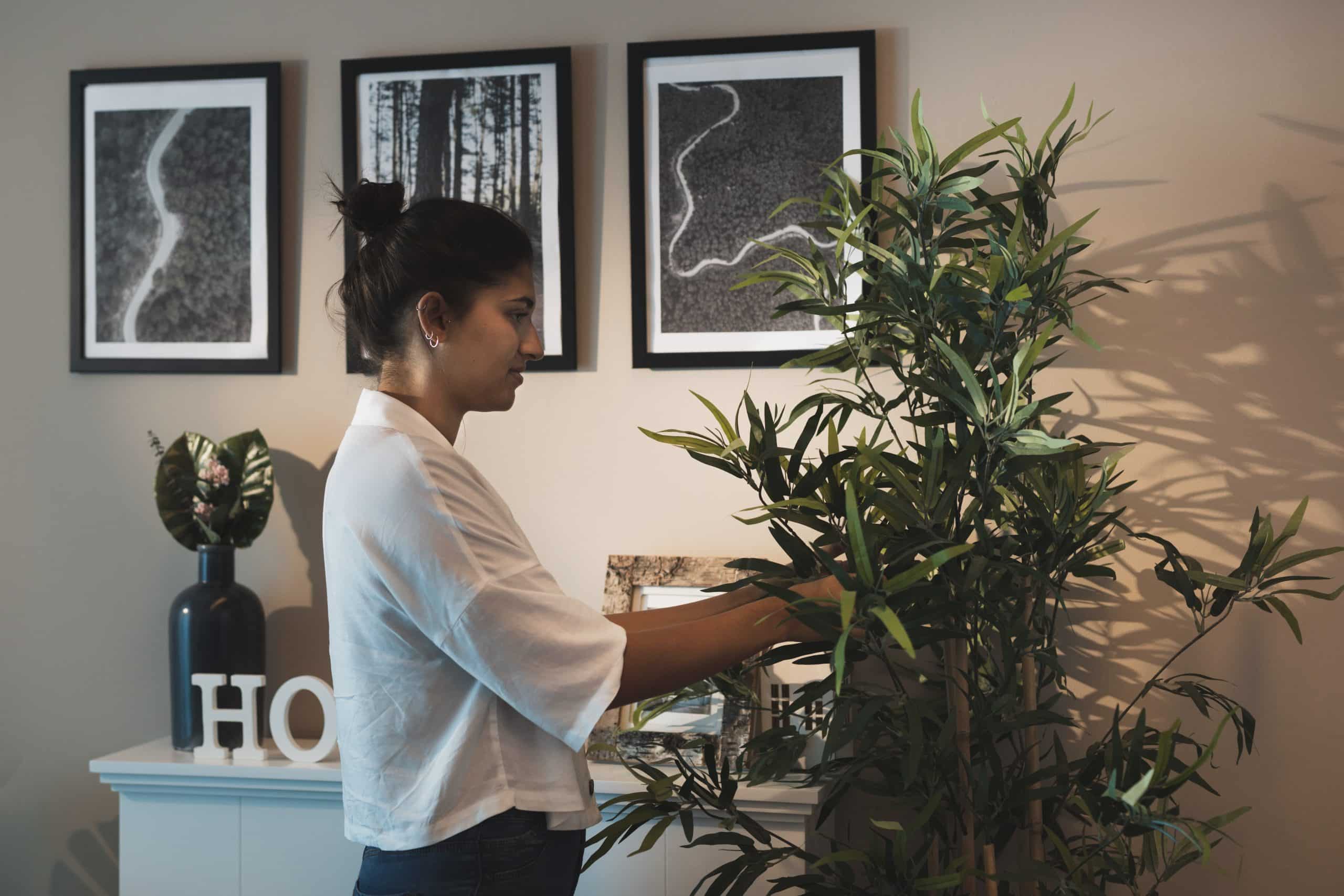Biophilic design elements: Enhance your space naturally

In the contemporary landscape of architecture and urban planning, an innovative and profoundly impactful approach is gaining prominence: the integration of biophilic design elements.
This design philosophy, which transcends mere aesthetics, is revolutionizing how we interact with the built spaces around us.
It’s an invitation to reflect on an innate sensation that many experience of how being close to nature invariably makes us feel better, calmer, more productive, and happier. This deep connection, dating back to the dawn of human existence, is at the core of biophilic design.
This article will delve into how biophilic design elements not only can, but should, be incorporated to optimize our daily environment, promoting mental health, physical well-being, and a more harmonious lifestyle.
Understanding biophilic design elements
The essence of understanding biophilic design lies in exploring how our intrinsic and innate connection with nature can be reflected, and even recreated, in human-built environments.
This design approach is not a fleeting novelty, but rather a profound rediscovery of our biological need to connect with living systems and natural processes. It explicitly aims to enhance our overall well-being, mental health, and happiness by strategically incorporating biophilic design elements.
When we consider the guiding principles of biophilic design, a series of fundamental components emerge, and their intelligent use can be applied in a vast range of settings, from welcoming homes and dynamic offices to healthcare environments and educational spaces, all with the purpose of cultivating a healthier and more regenerative atmosphere.
Integrating nature into our spaces involves a series of essential principles that work interdependently to create truly biophilic environments.
Natural light is one of the most powerful biophilic design elements. Maximizing daylight in indoor spaces not only improves visibility but also stimulates a deep sense of openness, vitality, and connection to the natural cycles of the day.
Having views of nature, such as windows that open onto lush green areas, natural landscapes, or tranquil bodies of water, can have a profoundly positive impact on mood, productivity, and stress reduction.
The choice of biophilic materials is another fundamental pillar; this involves using materials that emulate the texture, color, and sensibility of natural elements — such as solid wood, natural stone, and organic fabrics — which together create a welcoming, calming, and texturally rich environment.
Finally, incorporating living spaces, through vibrant indoor plants, green walls, or even small indoor gardens, not only improves air quality but also promotes a state of relaxation and a sense of continuous revitalization.
The transition to a more biophilic approach means acknowledging the undeniable importance of these connections to our holistic health.
Robust and growing scientific studies consistently demonstrate that nature-rich environments can significantly lower stress levels, increase creativity, improve concentration, and accelerate recovery in healthcare settings.
This makes the application of biophilic design elements particularly relevant in workspaces where productivity and employee well-being are essential, and in hospitals where recovery is the priority.
In practical terms, creating spaces that reflect these principles is achievable for everyone, regardless of scale. Start with simple changes, like introducing a few plants into your home or office, or even opting for decorative elements that use natural materials in their composition.
Even small adjustments can make a profound impact. Ultimately, understanding the fundamentals of biophilic design empowers us to create environments that are not only aesthetically pleasing but, more crucially, nurture our intrinsic well-being, utilizing the wisdom contained within biophilic design elements.
Key principles of biophilic design elements
The key elements of biophilic design are essential components for creating environments that intrinsically promote human well-being. These elements not only intensify our fundamental connection to nature but also transform spaces, making them more welcoming, inviting, and conducive to health.
At the heart of biophilic design is the profound conviction that nature should be incorporated fluidly and consciously into our daily lives, rather than just as an optional accessory.
Understanding these crucial elements is the first step for anyone wishing to embark on the journey of incorporating biophilic principles into their own surroundings.
The use of natural materials is a significant aspect of biophilic design elements. The choice of materials that mirror the natural world, such as the robustness of wood, the solidity of stone, and the lightness of natural fibers, has the power to make spaces feel warmer, more organic, and inherently more appealing.
Wood, for example, adds a sense of warmth and evokes a primal connection to forests and wilderness. Stone provides a sense of stability and a touch of the earth, anchoring interiors. And natural fabrics, such as organic cotton, wool, and linen, offer tactile comfort and promote a genuinely natural aesthetic.
Another vital and indispensable aspect is the incorporation of natural light. Daylight profoundly influences our mood, energy levels, and circadian rhythms, making the maximization of sunlight in indoor spaces absolutely crucial.
Designs that prioritize large windows, strategically positioned skylights, or glass walls can flood an environment with light, creating a bright, airy, and uplifting atmosphere.
To optimize natural light, one can use translucent curtains that softly filter light while maintaining privacy, or explore creating open layouts that facilitate light flow throughout the home.
Additionally, considering views of nature can fundamentally alter how we perceive and feel about a space. When we can look outside and contemplate majestic trees, well-maintained gardens, or untouched natural landscapes, it instills an immediate sense of calm, spaciousness, and connection to the outside world.
Research unequivocally demonstrates that such views can significantly reduce stress, improve concentration, and enhance productivity, reinforcing the power of biophilic design elements.
Water features also play a very important role in biophilic design. The soft, rhythmic sound of running water, the presence of a small indoor fountain, or a reflecting pool can create an atmosphere of tranquility and serenity in any environment.
Besides providing visual and auditory interest, indoor water elements can improve air quality, increase humidity, and offer a cooling effect, both physically and emotionally, contributing to overall well-being.
Finally, the integration of plants into designs cannot be overlooked. Indoor plants not only beautify a space with their vibrant shapes and colors but also improve air quality by filtering toxins and releasing oxygen.
They promote a healthy and living atmosphere, adding life and dynamism even to the simplest rooms and fostering a sense of continuous well-being.
Plants are, par excellence, one of the most accessible and powerful biophilic design elements, bringing the vitality of nature directly indoors to homes or offices.

Impact of nature on mental health
The impact of nature on mental health is an increasingly robust area of study, with overwhelming scientific evidence proving its depth and reach.
Regular exposure to natural environments, whether in their wildest form or in carefully designed green spaces, can significantly improve our mental and emotional well-being, acting as a powerful antidote to the challenges of modern life.
It has been observed that by spending time in natural settings, even for brief periods, symptoms of anxiety and depression can be remarkably reduced.
A simple walk in a wooded park, for example, has the power to clear the mind, decrease the rumination of negative thoughts, and boost mood almost instantly.
Natural settings offer a peaceful escape from the incessant demands of our busy lives, allowing us to recharge and reconnect with a sense of balance and calm. This is the crucial point where biophilic design elements come into play, bringing these benefits into built spaces.
Engagement with the natural world offers a range of tangible and valuable psychological benefits. Stress reduction is one of the most prominent; nature can lower cortisol levels, the stress hormone, helping the body better manage stress responses.
Mood is consistently enhanced; people frequently report feeling happier, more content, and more relaxed when surrounded by nature.
Creativity is boosted through exposure to natural environments, which stimulate divergent thinking and problem-solving skills. Furthermore, focus and attention are improved; the tranquility of natural settings can help restore attention levels and combat mental fatigue, especially that caused by digital overstimulation.
By incorporating even a few biophilic design elements into our daily routines, we can experience these benefits continuously.
For example, the simple addition of plants to your workspace or home can create a calming atmosphere, reduce stress, and increase a sense of vitality.
Many companies and institutions are now actively redesigning their spaces with indoor gardens, green walls, and abundant vegetation to promote a healthier and more productive work environment, recognizing the intrinsic value of this connection.
Additionally, studies indicate that even viewing nature scenes, whether through large windows, artworks, or digital projections, can improve mood and focus.
This is why many hospitals, schools, and corporate offices are integrating panoramic views of nature into their architectural designs, demonstrating a growing awareness of the power of biophilic design elements.
Access to nature, even in small doses and in dense urban environments, can lead to significant mental health benefits, reinforcing the idea that nature is not a luxury but a necessity.
Ultimately, the profound connection between nature and mental health highlights the vital importance of prioritizing time outdoors and integrating biophilia into our built environments.
Whether through gardening, hiking in the woods, or simply sitting in a park, engaging with nature, facilitated by biophilic design elements, can deeply influence our well-being and quality of life.
Psychological benefits of nature
Engaging with the natural world offers several psychological benefits:
- Stress Reduction: Nature can lower cortisol levels, which helps in managing stress.
- Enhanced Mood: People often report feeling happier and more content when surrounded by nature.
- Increased Creativity: Being in nature boosts creative thinking and problem-solving skills.
- Improved Focus: The tranquility of natural settings can help restore attention levels.
By simply incorporating a few elements of nature into our daily routines, we can experience these benefits. For instance, bringing plants into your workspace can create a calming atmosphere and help alleviate stress.
Additionally, studies indicate that even viewing nature scenes can improve mood and focus. This is why many hospitals and schools include natural views in their architecture.
Ultimately, the connection between nature and mental health highlights the importance of prioritizing time outdoors. Whether it’s gardening, hiking, or simply sitting in a park, engaging with nature can deeply influence our well-being.
Incorporating biophilic design at home
Incorporating biophilic design at home is an exceptionally effective way to enhance your living space, transforming it into a sanctuary of well-being and a tangible bridge to nature.
Even the simplest changes can have a profound impact, making your home more inviting, healthy, and harmonious. The beauty of biophilic design elements lies in their flexibility and adaptability to different styles and budgets, allowing anyone to create a more connected and revitalizing environment.
One of the most direct and impactful ways to start is by introducing indoor plants. Plants are not just decorative elements; they are living organisms that actively contribute to improving air quality, filtering toxins, and releasing fresh oxygen.
In addition to purifying the environment, their mere presence can create an inherently calming atmosphere and a deep sense of peace, making your home more serene and livable.
Choosing plants with different textures and colors can add an extra layer of visual and sensory interest, enhancing the biophilic design elements within your home.
Another key aspect of biophilic design that translates beautifully to the home environment is the maximization of natural light.
Sunlight is a powerful mood and well-being booster, and designs that prioritize large windows, glass doors, or open layouts can flood your home with light, making spaces feel larger, airier, and intrinsically more connected to the outdoors.
If possible, furniture should be arranged to take full advantage of natural light sources, creating warm and inviting nooks. To optimize natural light, one can: opt for sheer curtains, which allow light to filter softly while maintaining privacy.
Install skylights, which are excellent for bringing natural light into darker spaces, such as hallways or bathrooms; and prioritize open-plan layouts, which facilitate the flow of light throughout the home.
The choice of textures and materials also plays a significant role in creating a biophilic environment. Consider using natural materials like wood, stone, bamboo, wicker, or ceramics in your decor and furnishings.
These elements are not only aesthetically beautiful but also evoke a tactile and visual sense of being outdoors, connecting you to the earth and its natural resources.
To reinforce the integration of biophilic design elements, think about surfaces that evoke natural textures, such as unpolished stone countertops or rustic wooden floors.
In your home decor, consider incorporating nature-inspired colors, such as a palette of soft greens, serene blues, and warm earthy tones.
These colors have the ability to create a relaxing and comforting environment. Artwork depicting natural landscapes, flora and fauna, or featuring textures reminiscent of natural elements can also enhance the feeling of connection to the outdoors.
Another excellent option is the creation of outdoor living spaces that function as extensions of your home. Patios, balconies, decks, or well-maintained gardens can serve as additional areas for relaxing, working, or socializing, all while enjoying fresh air and sunshine.
Adding comfortable seating areas among the greenery can be a sublime way to spend time outdoors without leaving home, maximizing the use of biophilic design elements on your property.
In essence, transforming your home through biophilic design is a continuous investment in your own well-being, creating a sanctuary that nurtures both soul and body.
Biophilic design in urban planning
Biophilic design in urban planning is becoming an increasingly crucial and urgent aspect as cities around the world continue their inexorable expansion and our intrinsic connection with the natural world seems to progressively diminish.
This visionary approach to urban planning is not limited to adding mere green adornments; it focuses on a deep and systemic integration of nature into dense urban environments, with the primary goal of enhancing the quality of life for its inhabitants.
By emphasizing the creation and maintenance of vast green spaces, urban planners can design urban areas that are inherently healthier and more resilient.
Extensive urban parks, innovative green roofs, vegetated facades, and dense urban forests not only beautify cities but also provide vital ecosystems for wildlife, improve biodiversity, and, crucially, offer residents essential areas for recreation, relaxation, and a refuge from urban hustle and bustle.
The strategic incorporation of biophilic design elements in city design can significantly reduce air and noise pollution, as well as mitigate the urban heat island effect.
Implementing biophilic design in urban environments brings numerous benefits that directly impact population health and well-being.
Improved air quality is one of the most direct; plants and trees act as natural filters, removing pollutants and particles from the air, which is vital for respiratory health in densely populated areas.
Enhanced well-being is another fundamental benefit; regular access to and exposure to green spaces are unequivocally linked to better mental health, reduced stress levels, and encouragement of physical activity, promoting a more active and healthy lifestyle.
Urban heat reduction is a significant environmental advantage; vegetation can lower the urban heat island effect, reducing temperatures in densely built areas, which is crucial in a climate change scenario.
Creation of wildlife habitats supports local biodiversity, allowing birds, insects, and other forms of life to thrive amidst the urban landscape. Another essential aspect of biophilic urban design is the integration of water features.
Natural streams, ponds, fountains, and reflecting pools not only enhance the aesthetic appeal of public spaces but also promote biodiversity by attracting various species and aid in stormwater management.
These elements not only provide visual and auditory interest but also play a vital role in improving the overall ecological health of the city.
Creating walkable neighborhoods that organically integrate nature fosters a strong sense of community and belonging. By designing pedestrian pathways lined with leafy trees, lush gardens, and small parks, urban planners encourage social interaction, outdoor exercise, and a healthier lifestyle for residents.
This type of design, rich in Biophilic design elements, not only makes cities more livable and accessible but also promotes a culture of well-being and active living.
Innovative projects worldwide brilliantly demonstrate how biophilic design can truly transform urban spaces.
From eco-districts planned with a focus on sustainability to skyscrapers incorporating vertical gardens and green terraces, the integration of nature into architecture and urban planning is helping cities adapt to climate change challenges, while drastically enhancing the quality of life for their inhabitants.
Incorporating biophilic design elements into our spaces — whether in our homes, workplaces, or in large-scale urban planning projects — can significantly enrich our connection with the natural world.
By integrating natural elements, we improve not only our physical environments but also our mental and emotional health. Abundant green spaces, optimized natural lighting, and the intelligent use of organic materials are pillars that promote healthier lifestyles and create vibrant, resilient, and truly human communities.
As cities continue to grow and evolve, embracing and expanding biophilic principles is essential for building more livable, sustainable, pleasurable, and, above all, well-being-focused environments for everyone.
FAQ – Frequently Asked Questions about Biophilic Design
What is biophilic design?
Biophilic design is an approach that integrates nature into environments to enhance well-being and improve mental health.
How can I incorporate biophilic design at home?
You can add indoor plants, maximize natural light, and use natural materials in your decor to create a biophilic environment.
What are the benefits of biophilic design in urban planning?
Biophilic design in urban planning creates greener spaces, improves air quality, and fosters community interaction, leading to healthier cities.
Why is access to nature important for mental health?
Access to nature has been shown to reduce stress, enhance mood, and increase overall well-being, making it vital for mental health.





